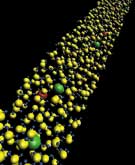
Issue No 6: May 2003
![]()
Computer simulation
techniques to study the adsorption and transport of ions in nanostructures
have been developed at The University of Hong Kong.
![]() Findings from
the theoretical models have important implications for nanomaterials in
general, said Principal Investigator Prof K Y Chan.
Findings from
the theoretical models have important implications for nanomaterials in
general, said Principal Investigator Prof K Y Chan.
![]() In fuel cells,
for example, performance depends on the passage of ions through nanopores
of the electrode material. “At the nano level, if we can control
and optimise the passage of ions, we can make the fuel cell more efficient,”
he said.
In fuel cells,
for example, performance depends on the passage of ions through nanopores
of the electrode material. “At the nano level, if we can control
and optimise the passage of ions, we can make the fuel cell more efficient,”
he said.
![]() Researchers
wrote computer code to produce theoretical models which are visualised
via a graphic tool. Results are focused on the “confining effect”
of nanopores where adsorption and transportation of ions depends on the
size of the nanopore.
Researchers
wrote computer code to produce theoretical models which are visualised
via a graphic tool. Results are focused on the “confining effect”
of nanopores where adsorption and transportation of ions depends on the
size of the nanopore.
Principal Investigator
Prof K Y Chan : hrsccky@hku.hk
![]()
 |
| Graphic simulation of electrolytes in a nanopore |